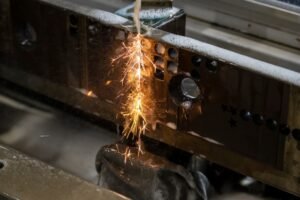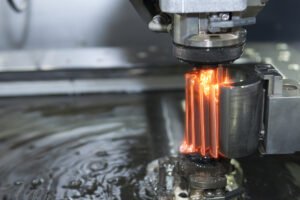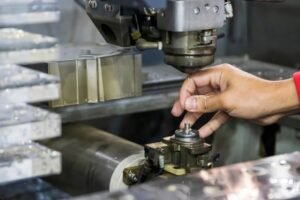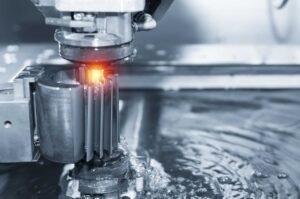Welcome to MaTec Vietnam! As we embark on our exploration of EDM Machining, it’s essential to understand its fundamentals and the various types it encompasses.
From the basics of Electrical Discharge Machining to its diverse applications, join us on this article as we delve into the intricacies of this cutting-edge manufacturing process. Let’s uncover the fascinating world of EDM Machining together!
What is EDM Machining
EDM Machining, short for Electrical Discharge Machining, is a manufacturing technique that removes material from a workpiece using rapid electrical discharges between submerged electrodes in a special liquid. This process is particularly useful for creating parts that are difficult or impossible to produce through conventional machining methods. Unlike traditional machining, EDM doesn’t rely on mechanical force.
This method is highly precise, making it perfect for crafting intricate and complex shapes, even from tough materials like titanium. However, it’s important to note that the materials being shaped must be electrically conductive for the process to work effectively.
In EDM, the workpiece electrode (anode) is connected to the positive terminal of a DC power supply, while the tool electrode (cathode) is linked to the negative terminal. Both electrodes are immersed in a dielectric fluid and separated by a small gap where sparking occurs. This sparking generates intense electrothermal heat, melting and vaporizing parts of the workpiece surface, a phenomenon known as spark erosion.

How Does EDM Machining Work?
While the basic principles of EDM machining remain consistent, there are notable differences between wired EDM and sinker EDM processes. Both methods employ anodes and cathodes to shape workpieces, yet their execution via electrical current varies significantly.
In sinker EDM machining, an electrical potential difference is established between the tool and work material, both immersed in a dielectric fluid like hydrocarbon oil or deionized water. The spark gap separating the tool and workpiece is filled with this fluid, creating an electric field determined by the potential difference and gap distance.
The tool, connected to the negative terminal, experiences electrostatic forces as the electric field initiates. Cold emission of electrons occurs if the tool possesses a lower work function or bonding energy, with these electrons accelerated towards the work material through the dielectric medium. Collisions between electrons and dielectric molecules lead to ionization, generating positive ions and electrons.
This cyclic process elevates electron and ion concentrations, forming a plasma channel with low electric resistance. An avalanche effect occurs, with a large flux of electrons moving from the tool to the work, accompanied by ions shifting from the work to the tool. This electron motion generates thermal energy, with temperatures ranging from 8,000°C to 12,000°C, impacting the workpiece surface and converting into heat flux.
In contrast, EDM wire machining functions akin to a wood band saw, utilizing a wire for cutting. The wire, typically copper or brass, undergoes high-voltage electrical discharge, enabling it to cut through the workpiece thickness. This process occurs in deionized water, precisely controlling conductivity while cooling the material and flushing away debris with clean dielectric fluid.
The extreme temperatures of EDM swiftly remove material via vaporization, melting, or spark erosion. As the electric potential is withdrawn, pressure or shock waves evacuate molten material, forming craters around the spark site. This material removal is facilitated by shock waves as the plasma channel collapses due to electric potential discontinuation, resulting in tool wear from positive ion strikes.
EDM machining demands significant power, with generators selected based on their ability to meet process power requirements. Efficient operation hinges on a generator’s capacity to deliver requisite power parameters.

Types of EDM Machines
Conventional EDM Machines
Also referred to as sinker EDM, die sinking, volume EDM, ram EDM, or cavity-type EDM, conventional EDM machines are renowned for their ability to produce intricate shapes.
Utilizing machining techniques, conventional EDM machines create a unique shape of an electrode that is submerged deeply into the material to be machined. This inverse replica is a negative impression of the electrode’s shape.
Capabilities and Applications of Conventional EDM Machines
Conventional EDM machines excel in using shaped electrodes, making them ideal for crafting dies and molds, especially for small-batch production or prototyping. They find widespread application across industries such as automotive and aerospace, precisely manufacturing complex engine components. Additionally, they are commonly employed in injection molding processes.
Wire EDM Machines
Also known as wire burning, spark EDM, or wire erosion machines, wire EDM utilizes a thin heated wire as an electrode, guided by hard diamond to maintain stability. The wire electrode traverses the workpiece, shaping it with electrical discharges, while the wire itself does not make physical contact with the workpiece. In wire EDM, the wire moves slowly.
This type of EDM ensures a continuous, uninterrupted cutting process as the wire continuously unspools from an automated feeder. For shapes requiring cuts through the middle rather than along the periphery, machinists often combine wire EDM with hole-drilling EDM. In this technique, a small hole is drilled through the center of the work material, allowing the wire to be threaded through for precise shaping. The electrodes in this process are tube-shaped, with dielectric fluid flowing through them to the hole.

Capabilities and Applications of Wire EDM Machines
Wire EDM machines offer distinct advantages, including robust and reliable performance, cutting-edge technology, and user-friendly operation. Key advantages over conventional EDM include:
- Ease of production
- Speed
- Low maintenance
Unlike traditional EDM, where electrodes are subject to erosion and require frequent replacement, wire EDM eliminates the need for pre-machining electrodes of specific shapes. Wire EDM is ready for operation as soon as the wire is installed, saving time and material costs associated with pre-machining. It finds suitability in time-sensitive applications and shapes where machining matching electrodes would be challenging. Moreover, wire EDM is commonly used in extrusion dies.
>>> Read more: Vietnam CNC Machining Shop: A Comprehensive Overview
Pros and Cons of EDM Machining
Pros
- Usable on heat-treated and hard materials.
- Capability to replicate complex shapes accurately.
- High precision achievable, approximately 0.005 mm.
- Economically produces fine surface finishes, up to 0.2 microns.
- Comparable machining time to conventional methods.
- Absence of mechanical stresses as no direct contact between tool and workpiece.
- Longer tool lifespan due to effective lubrication and cooling.
- Facilitates the development of erosion-resistant hard surfaces on dies.
- Suitable with any substance that conducts electricity
Cons
- Tool wear can be excessive.
- Inability to reproduce sharp corners.
- Alters material metallurgical properties due to high heat development.
- Limited to electrically conductive materials.
- Requires tool redressing for deep holes.
- Formation of over-cut.
- Challenges in finding skilled machinists.
Conclusion
Overall, EDM Machining, also known as Electrical Discharge Machining, is a cutting-edge manufacturing process that utilizes electrical discharges to shape conductive materials with precision.
By carefully controlling electrical sparks between an electrode and the workpiece, EDM can create intricate shapes and intricate details that may be difficult or impossible to achieve with conventional machining methods.
This technique is widely used in industries such as aerospace, automotive, and medical device manufacturing for its ability to produce high-quality, complex parts with tight tolerances. In today’s competitive manufacturing landscape, EDM machining stands out as a vital tool for pushing the boundaries of design and engineering possibilities.

